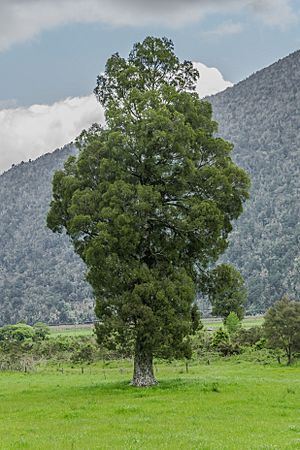New Zealand cedar facts for kids
Quick facts for kids New Zealand cedar |
|
|---|---|
 |
|
| Conservation status | |
| Scientific classification | |
| Genus: |
Libocedrus
|
| Species: |
bidwillii
|
The Libocedrus bidwillii, also called pāhautea or New Zealand cedar, is a special tree found only in New Zealand. It belongs to the cypress family, called Cupressaceae. This tree is an endemic species, meaning it naturally grows only in New Zealand and nowhere else in the world.
Contents
What's in a Name?
This tree got its scientific name, Libocedrus bidwillii, from John Carne Bidwill. He was a botanist and explorer from New Zealand.
People in New Zealand often call this tree by its Māori names, pāhautea or kaikawaka. However, experts from the DOC prefer the name pāhautea.
About the Pāhautea Tree
The pāhautea is an evergreen coniferous tree. This means it keeps its leaves all year round, and it produces cones instead of flowers. It can grow very tall, up to 25 meters (about 82 feet). Its trunk can be quite wide, reaching 2.5 meters (about 8 feet) across.
Leaves and Cones
The leaves of the pāhautea are small and look like scales. They are about 1.5 to 2 millimeters long. They grow in flat sprays on the branches.
The tree's seed cones are shaped like cylinders and are 8 to 12 millimeters long. Each cone has four scales. The seeds inside these cones have small wings, which help them fly away when the wind blows. The cones are ready about six to eight months after the tree is pollinated.
Pāhautea Wood
The wood from the pāhautea tree is not often used for commercial purposes. It is very light and has a unique light purple color when freshly cut. Sometimes, this wood is used to build lightweight sailing boats because it's easy to glue and holds nails well.
Where Pāhautea Trees Grow
You can find the pāhautea tree in both the North Island and the South Island of New Zealand. In the North Island, it grows from the Te Aroha area southwards.
These trees like to grow in temperate rainforests. They are usually found at altitudes between 250 and 1,200 meters (about 820 to 3,900 feet) above sea level. You won't find them on Stewart Island.
Protecting the Pāhautea
The Libocedrus bidwillii is currently listed as a near-threatened species. This means that while it's not in immediate danger, its population could become threatened if things don't change.
One of the biggest threats to the pāhautea, besides logging, comes from possums. Possums like to eat the leaves and bark of these trees. If too many possums feed on a pāhautea tree, it can seriously damage or even kill the tree.
Gallery
-
Libocedrus bidwillii on the skyline at Leith Saddle near Dunedin, New Zealand
See also
 In Spanish: Libocedrus bidwillii para niños
In Spanish: Libocedrus bidwillii para niños





